China’s Hydropower Resources and Development
Abstract
:1. Introduction
1.1. Background
1.2. Contributions and Organizations
2. Hydropower Reserves and Their Distribution in China
2.1. The Hydropower in the Yangtze River Basin (YRB)
2.2. The Pearl River Basin and Its Hydropower
2.3. The Yellow River Basin and Its Hydropower
2.4. The Brahmaputra and Other Interior Rivers of the Tibet Basin
2.5. The Southwest International Rivers Basin
2.6. The Southeastern Rivers Basin
2.7. The Northeastern Rivers Basin
2.8. The Huai River Basin
2.9. The Hai River and Luan River Basins
2.10. The Northwest Inland Rivers Basin
3. Hydropower Resources Development in China
3.1. Large and Medium-Scale Hydropower Stations Construction and Its Benefit in the Yangtze River Basin
3.2. The Main Large and Medium-Sized Hydropower Stations in the Pearl River Basin
3.3. The Main Large and Medium-Sized Hydropower Stations in the Yellow River Basin
3.4. The Main Large and Medium-Sized Hydropower Stations in the Southwest International Rivers Basin
3.5. The Main Large and Medium-Sized Hydropower Stations in the Southeastern Rivers Basin
3.6. “Small Hydropower” (SHP) Development in China
3.7. Comparisons with Other Power Sources
4. Problems and Suggestions of Hydropower in China
4.1. Overview of Major Problems and Challenges
- Uneven regional distribution of hydropower resources. The water resources of China are richly endowed by nature and rank top of the world. However, due to distinguishing features of topography and precipitation, the distribution of hydropower resources is very uneven in China. For instance, in the Southwest Region, many rivers possess both abundant runoffs and very steep slopes, thus, there exists very abundant hydropower potential (accounting for 70.0% of the total) while North China lacks hydropower resources (accounting for 1.8% of the total) due to either lack of river or lack of falls.
- Cost-effectiveness and imbalanced development. Hydropower development requires large initial capital outlays, and this is traditionally conducted at the government level. In terms of generation equipment, hydropower is about 40 percent higher than thermal power in unit cost. The initial investment is huge, and the funds needed are mostly from loans, therefore asset liability ratio of hydropower enterprise, especially new hydropower, is almost beyond 70%, which increase the reimbursement pressure for large hydropower enterprises [34]. Otherwise, most of the hydropower resources are in the western regions, whereas most of the electricity consumption is required in the eastern and the southern coastal regions as well as some part of the central region. Hence, a national strategy for electricity transmission from western to eastern China has been formulated and that will cost a lot of money.
- Migration settlement. Due to a huge population, the migration settlement of reservoir regions in hydropower development is troublesome. For many years, construction leads to more than 22 million reservoir resettlements to distribute in 31 provinces and municipalities directly under the Central Government [31]. Along with the growing numbers of hydropower reservoirs construction, the contradiction between increasing migration settlement population and backward infrastructure construction in resettlement areas will become more prominent. Hence, it will become increasingly difficult to implement a hydropower project if the moving residents are not helped to settle down appropriately. In addition, population health and cultural relics and historic sites protections caused by migration have also caused extensive concern more and more.
- Ecologic environmental problems. Although hydropower is clean renewable energy with no carbon emissions, it still affects the ecological environment of the reservoir, and the exploitation causes a series of ecological disasters. As the scale of hydropower becomes larger and larger, the impact of uncertain runoff quantity on hydropower and power grids will become more significant. The impact of the extreme climate on the operation of hydropower stations will be even more. The drought in the southwestern region of the country in 2022 exhibits an important warning. As well as the development of hydropower projects changes the hydrology of the rivers and leads to water quality variation and geology state change. Thus, the rivers lost their self-protection ability and ecologic disasters such as earthquakes and mud-rock flow arise frequently. Moreover, the aquatic community that consists of fishes and plants will die because of reservoir inundation and the changes in living conditions, such as eutrophication [14]. According to the report released by the Ministry of Environment Protection (MEP), the water quality of the mainstream Yangtze River and its tributaries is slightly poorer in 2008. MEP asserted that it is mainly due to the major flooding during the autumn season [38].
- The immature industry system. While rapid development has been demonstrated in hydropower, a lot of challenges remain to be solved. A low level of industry concentration is one of the most challenging things that make it difficult to manage hydropower, especially for SHP. Most SHP stations are mountainous and have a wide distribution. The transmission network in such areas is usually weak and not well-developed [39]. Otherwise, the immature estimation system may cause excessive exploitation and utilization of hydropower resources and a few small hydropower projects don’t take into consideration of downstream production, living and ecological water requirement that cause discontinuous flow [34]. Furthermore, the overproduction of hydropower gives rise to the waste of power and increases the load instability of the grid in the grid-connection system. Indetermination of SHP property leads to market confusion in the SHP supply system regions. With little access to information and weak dispatching management, it is hard to control the output of SHP stations which consequently results in some large hydropower stations having no way but spillage due to network congestion [37]. China’s hydropower is at the stage of rapid development of industry, while large-scale construction is desired, few managements and research have been devoted.
- Hydropower project management risks. Effective management should be based on how to systematically balance the multiple objectives of sustainable development and address the balance among stakeholders. Thus, some risks that appear in the management should be taken into consideration. Hydropower project risk management involves a wide variety of factors, including estimations, contracts, clients, contractors, designers, unknown geological conditions, economic and political circumstances, technology issues, natural events, ecological and environmental impacts, affected local communities, management and control techniques, individual activities, organizational operations, and inter-organizational risk allocations [14] and there are a lot of studies have conducted these themes.
4.2. Suggestions
5. Conclusions
Author Contributions
Funding
Institutional Review Board Statement
Informed Consent Statement
Data Availability Statement
Conflicts of Interest
References
- Hydropower. Available online: https://www.iea.org/fuels-and-technologies/hydropower (accessed on 10 November 2022).
- Energy. Available online: https://www.iea.org/ (accessed on 10 November 2022).
- Yang, G.; Bai, Y.; Song, Y.; Metwally, A.; Mahmoud, O. An experimental study to measure oil recovery factor by chemical agents and carbon dioxide after waterflooding. Sci. Rep. 2022, 12, 9464. [Google Scholar] [CrossRef]
- Akpan, P.; Fuls, W. Cycling of Coal fired Power Plants: A generic CO2 emissions factor model for predicting CO2 emissions. Energy 2021, 214, 119026. [Google Scholar] [CrossRef]
- Galletti, A.; Avesani, D.; Bellin, A.; Majone, B. Detailed simulation of storage hydropower systems in large Alpine watersheds. J. Hydrol. 2021, 603, 127125. [Google Scholar] [CrossRef]
- Trottier, G.; Turgeon, K.; Boisclair, D.; Bulle, C.; Margni, M. The impacts of hydropower on freshwater macroinvertebrate richness: A global meta-analysis. PLoS ONE 2022, 17, e0273089. [Google Scholar] [CrossRef] [PubMed]
- Feng, Z.; Niu, W.; Cheng, C.; Zhou, J.; Yang, T. China’s hydropower energy system toward carbon neutrality. Front. Eng. Manag. 2022, 9, 677–682. [Google Scholar] [CrossRef]
- Zhao, X.; Wu, L. The Energy Injustice of Hydropower: Development, Resettlement, and Social Exclusion at the Hongjiang and Wanmipo Hydropower Stations in China. Energy Res. Soc. Sci. 2020, 62, 101366. [Google Scholar] [CrossRef]
- Wang, Y.; Liu, J.; Han, Y. Production capacity prediction of hydropower industries for energy optimization: Evidence based on novel extreme learning machine integrating Monte Carlo. J. Clean. Prod. 2020, 272, 122824. [Google Scholar] [CrossRef]
- Duan, B. Discussion on the development direction of hydropower in China. Clean Energy 2021, 5, 10–18. [Google Scholar]
- Li, X.; Chen, Z.; Fan, X.; Cheng, Z. Hydropower development situation and prospects in China. Renew. Sustain. Energy Rev. 2018, 82, 232–239. [Google Scholar] [CrossRef]
- Chinapower. Available online: http://www.chinapower.com.cn/informationzxbg/20190110/1262078.html (accessed on 10 December 2019).
- China Statistical Yearbook. Available online: http://www.stats.gov.cn/tjsj./ndsj/ (accessed on 10 December 2021).
- Tang, W.; Li, Z.; Qiang, M.; Wang, S.; Lu, Y. Risk management of hydropower development in China. Energy 2013, 60, 316–324. [Google Scholar] [CrossRef]
- Lu, X.; Fu, C. A General Survey of the Major Rivers in China; China Waterpower Press: Beijing, China, 2010. [Google Scholar]
- China Three Gorges Construction Engineering Corporation. Available online: http://www.ctgpc.com.cn/ (accessed on 10 December 2021).
- Pang, J.; Liu, H.; Liu, X.; Yang, H.; Peng, Y.; Zeng, Y.Y. Study on sediment erosion of high head Francis turbine runner in Minjiang River basin. Renew. Energy 2022, 192, 849–858. [Google Scholar] [CrossRef]
- Zhang, Q.; Xu, C.Y.; Zhang, Z. Observed Changes of Drought/Wetness 11 Episodes in the Pearl River Basin, China, Using the Standardized Precipitation 12 Index and Aridity Index; Springer: Vienna, Austria, 2009; Volume 98, pp. 89–99. [Google Scholar]
- Ni, Y.; Yu, Z.; Lv, X.; Qin, T.; Yan, D.; Zhang, Q.; Ma, L. Spatial difference analysis of the runoff evolution attribution in the Yellow River Basin. J. Hydrol. 2022, 612, 128–149. [Google Scholar] [CrossRef]
- Shen, J.; Zhang, H.; Zhao, Y.; Song, J. An examination of the mitigation effect of vegetation restoration on regional water poverty: Based on panel data analysis of 9 provinces in the Yellow River basin of China from 1999 to 2019. Ecol. Indic. 2023, 146, 109860. [Google Scholar] [CrossRef]
- Lyu, H.; Tian, F.; Zhang, K.; Nan, Y. Water-energy-food nexus in the Yarlung Tsangpo-Brahmaputra River Basin: Impact of mainstream hydropower development. J. Hydrol. Reg. Stud. 2023, 45, 101293. [Google Scholar] [CrossRef]
- Sun, L.; Niu, D.; Wang, K.; Xu, X. Sustainable development pathways of hydropower in China: Interdisciplinary qualitative analysis and scenario-based system dynamics quantitative modeling. J. Clean. Prod. 2021, 287, 125528. [Google Scholar] [CrossRef]
- Xu, B.; Li, Y.; Han, F.; Zheng, Y.; Ding, W.; Zhang, C.; Wallington, K.; Zhang, Z. The transborder flux of phosphorus in the Lancang-Mekong River Basin: Magnitude, patterns and impacts from the cascade hydropower dams in China. J. Hydrol. 2020, 590, 125201. [Google Scholar] [CrossRef]
- Li, B.; Xu, N.; Xiao, P.; Xia, Y.; Zhou, X.; Gu, G.; Yang, X. Microseismic monitoring and forecasting of dynamic disasters in underground hydropower projects in southwest China: A review. J. Rock Mech. Geotech. Eng. 2023; in press. [Google Scholar] [CrossRef]
- Jaap, E.; Assela, P. Adaptation to climate change in the Mekong River Basin: Introduction to the special issue. Clim. Chang. 2018, 149, 1–11. [Google Scholar]
- Cheng, Y.L.; Shen, H.; Xu, Y. Preliminary study on effects of Min River cascade hydropower stations on water environment. Water Resour. Prot. 2011, 27, 114–118. [Google Scholar]
- Gao, X.; Zhang, Y.; Ding, S.; Zhao, R.; Meng, W. Response of fish communities to environmental changes in an agriculturally dominated watershed (Liao River Basin) in northeastern China. Ecol. Eng. 2015, 76, 130–141. [Google Scholar] [CrossRef]
- Wang, G.; Xia, J. Improvement of SWAT 2000 modeling to assess the impact of dams and sluices on streamflow in the Huai River basin of China. Hydrol. Process. 2010, 24, 1455–1471. [Google Scholar] [CrossRef]
- State Statistical Bureau. Statistical Bulletin of National Economic and Social Development of the People’s Republic of China in 2021. 2021. Available online: https://data.stats.gov.cn/ (accessed on 27 November 2022).
- Chang, X.L.; Liu, X.; Zhou, W. Hydropower in China at present and its further development. Energy 2010, 35, 4400–4406. [Google Scholar] [CrossRef]
- National Electric Power Industry Statistics Express, n.d. 2014. Available online: http://www.sxcoal.com/dl/3636879/articlenew.html (accessed on 14 July 2016).
- International Hydropower Association. IHA Hydropower Report. 2013. Available online: https://www.hydropower.org/publications/2013-hydropower-report (accessed on 13 December 2022).
- Zhao, X.; Liu, L.; Liu, X.; Wang, J.; Liu, P. A critical-analysis on the development of China hydropower. Renew. Energy 2012, 44, 1–6. [Google Scholar]
- Liu, B.; Liao, S.; Cheng, C.; Chen, F.; Li, W. Hydropower curtailment in Yunnan Province, southwestern China: Constraint analysis and suggestions. Renew. Energy 2018, 121, 700–711. [Google Scholar] [CrossRef]
- CWSY. China Water Statistical Yearbook 2020; China Water Power Press: Beijing, China, 2020. [Google Scholar]
- Zhang, L.; Pang, M.; Bahaj, A.B.S.; Yang, Y.; Wang, C. Small hydropower development in China: Growing challenges and transition strategy. Renew. Sustain. Energy Rev. 2021, 137, 110653. [Google Scholar] [CrossRef]
- MEP. Ecological and Environmental Monitoring Report 2009 for the Three Gorges Project; The Ministry of the Environment Protection: Beijing, China, 2009. [Google Scholar]
- Thomas, H.; Wang, W.; Yan, F.; Qu, X.; He, D. Review of Yunnan’s hydropower development. Comparing small and large hydropower projects regarding their environmental implications and socio-economic consequences. Renew. Sustain. Energy Rev. 2013, 27, 585–595. [Google Scholar]
- Li, S.M. Research on Water Environment Simulation and Water Quality Assessment of the Cascade Hydropower Plant in the Supa River Basin. Master’s Thesis, Tianjin University, Tianjin, China, 2006. (In Chinese with English abstract). [Google Scholar]
- Li, J.; Tong, J.; Yuan, J. Discussion on Environment Impact Assessment of Immigrant Arrangement of Water Conservancy and Hydropower Project. J. Anhui Agric. 2007, 35, 81–82. [Google Scholar]
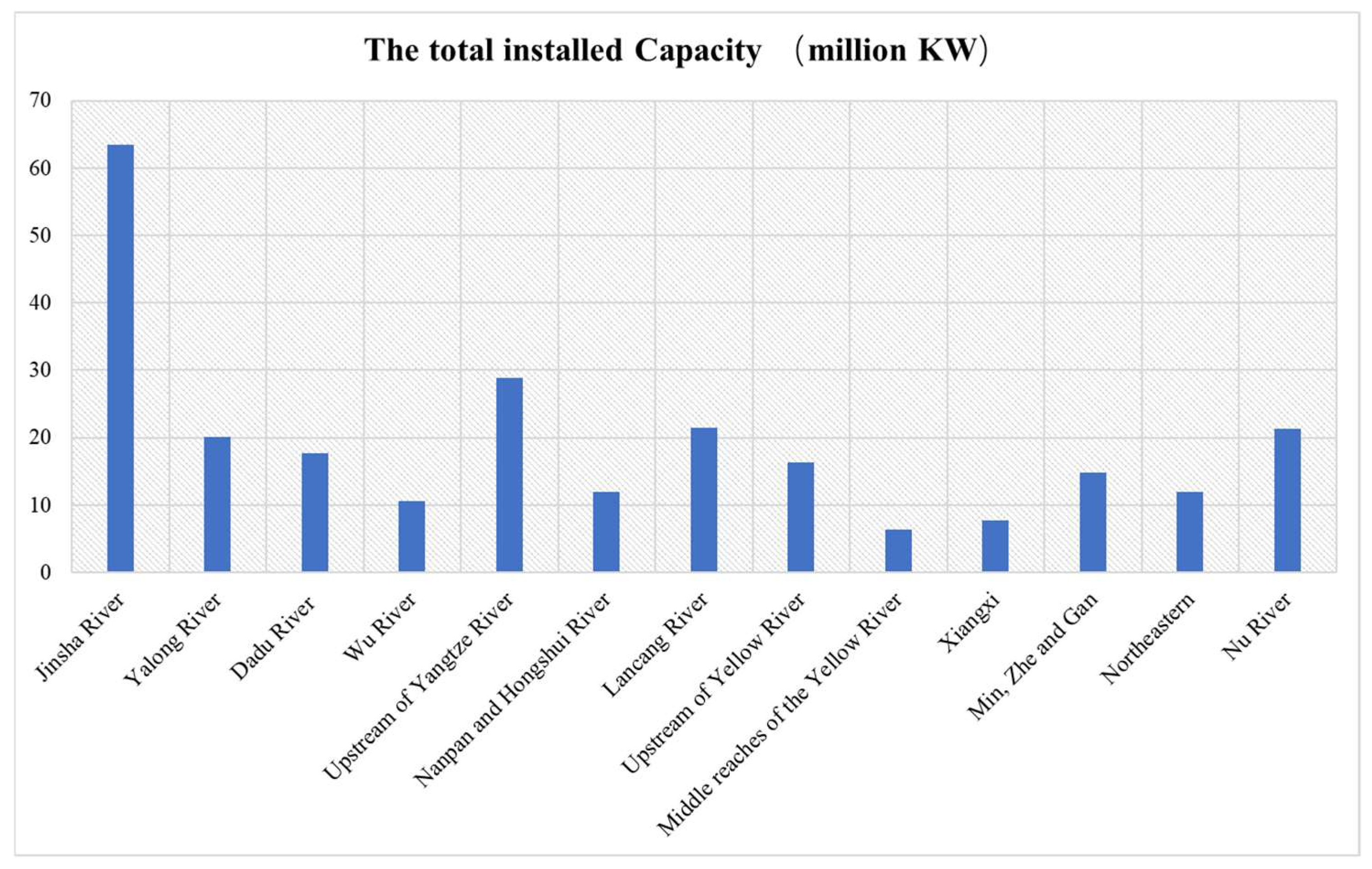
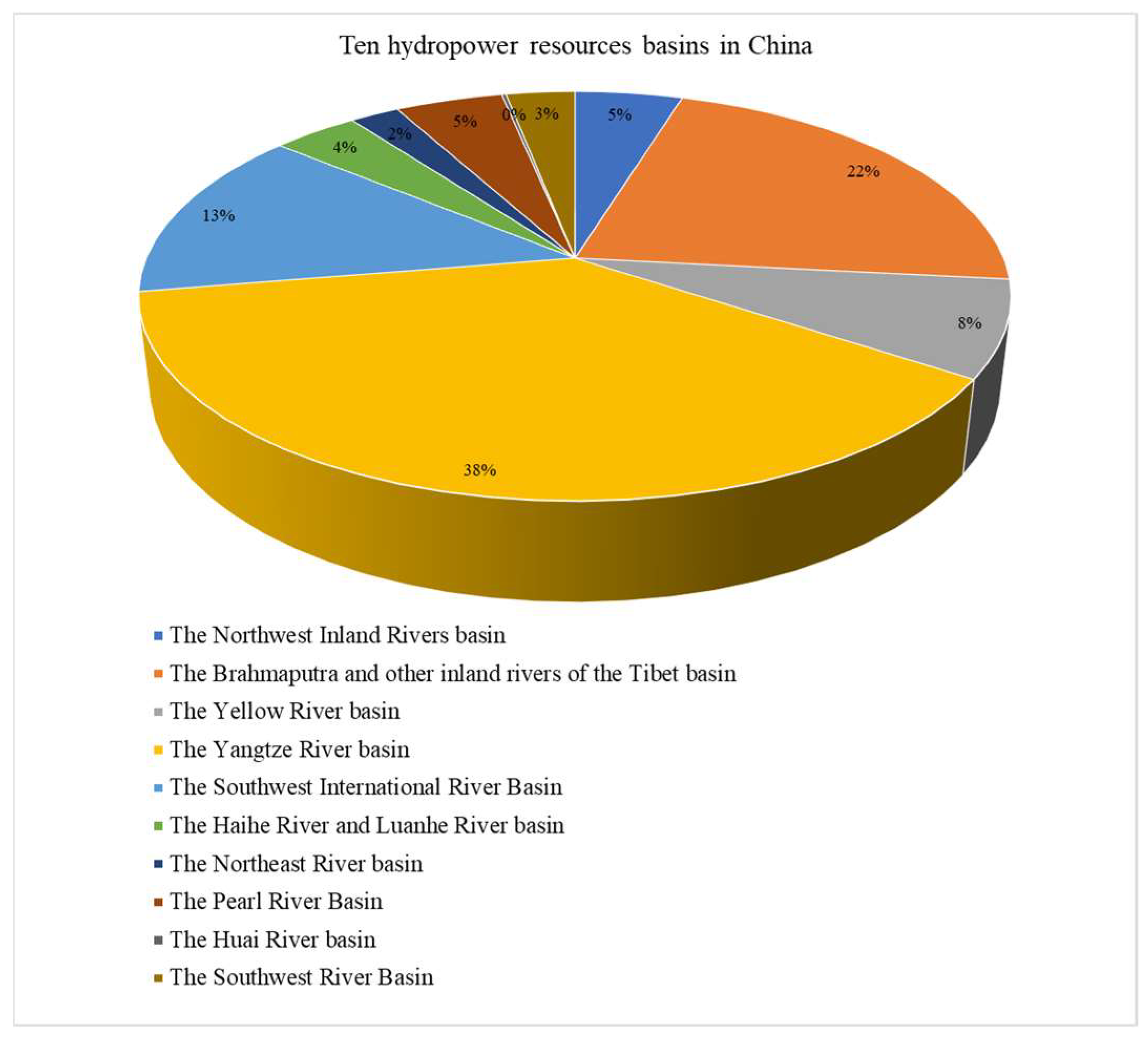
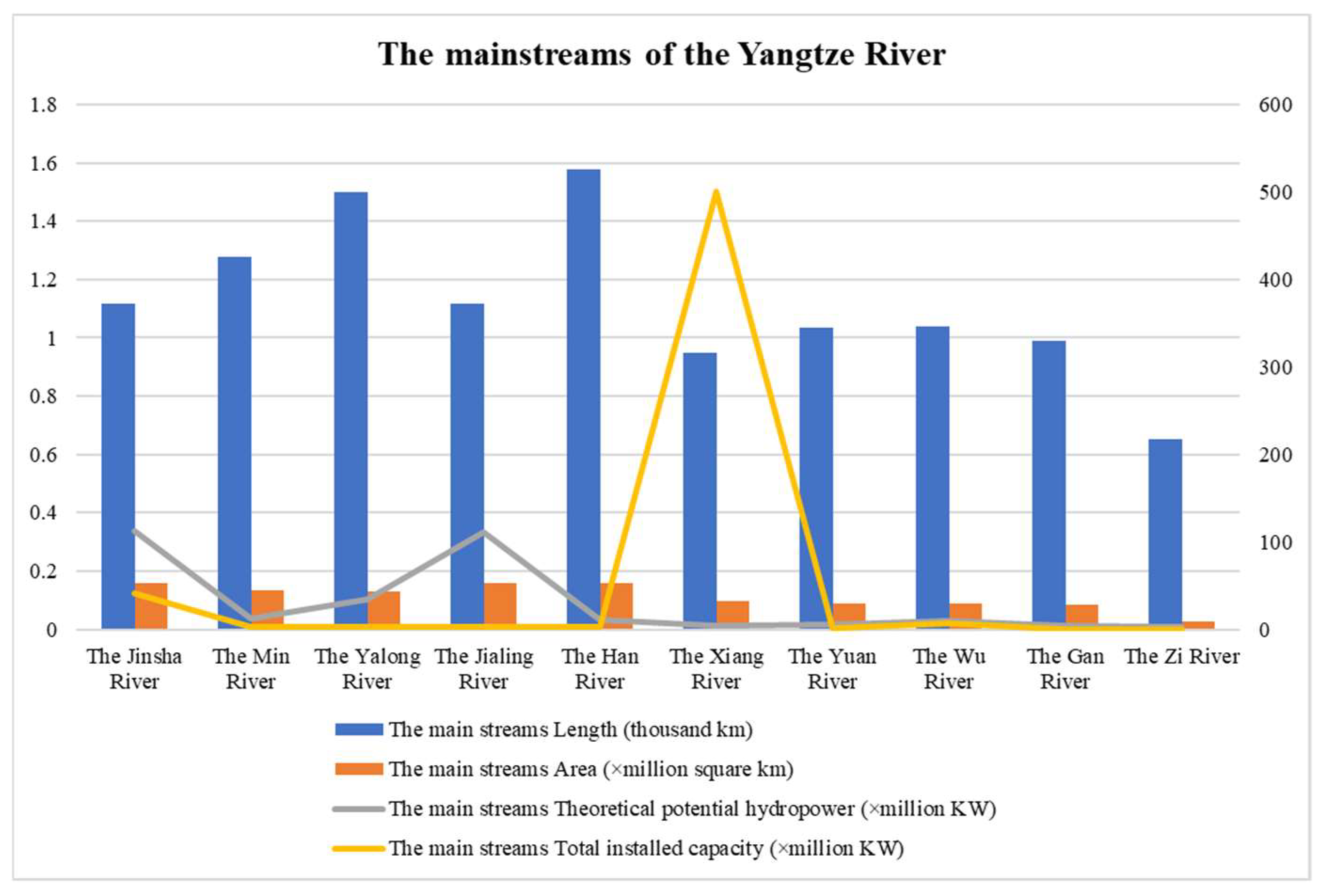
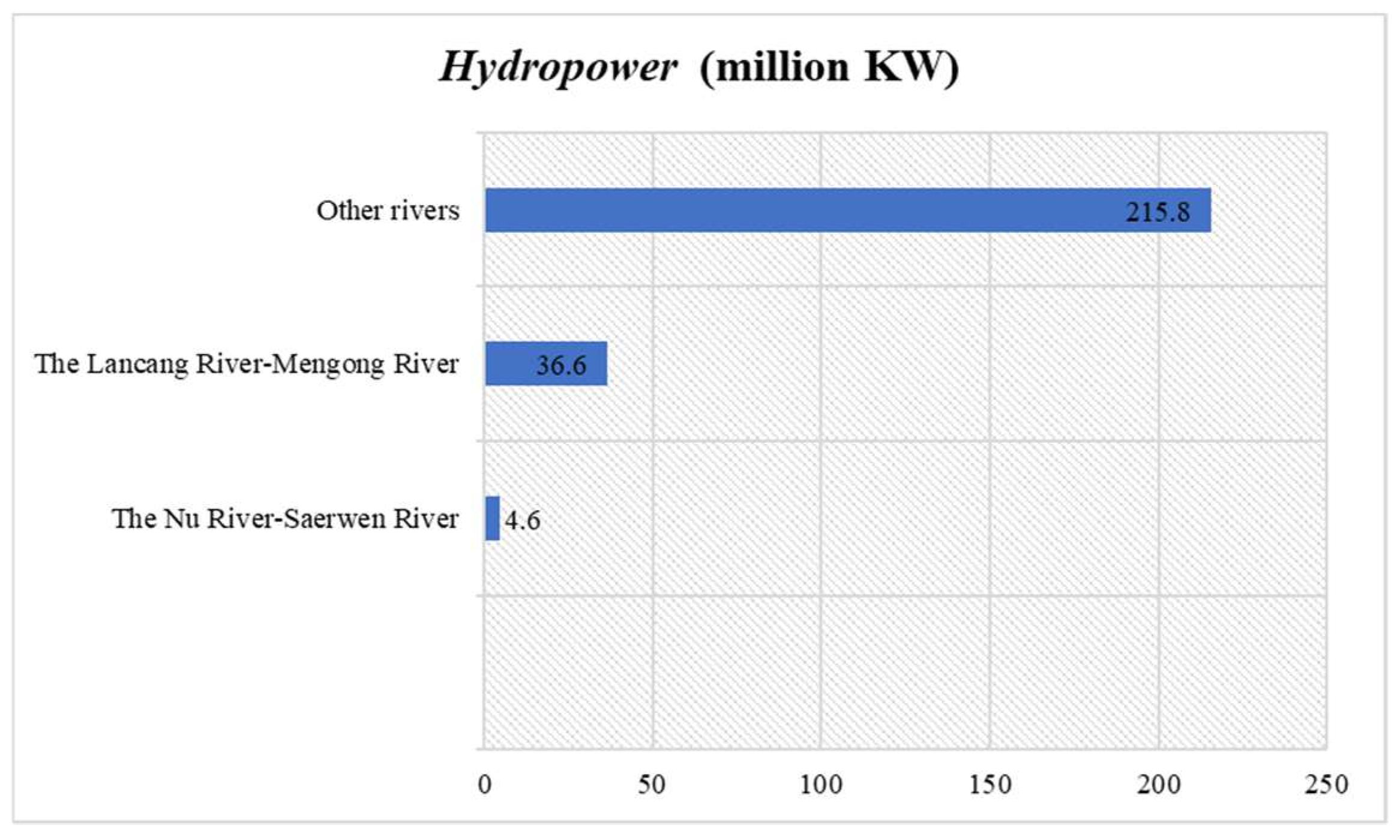

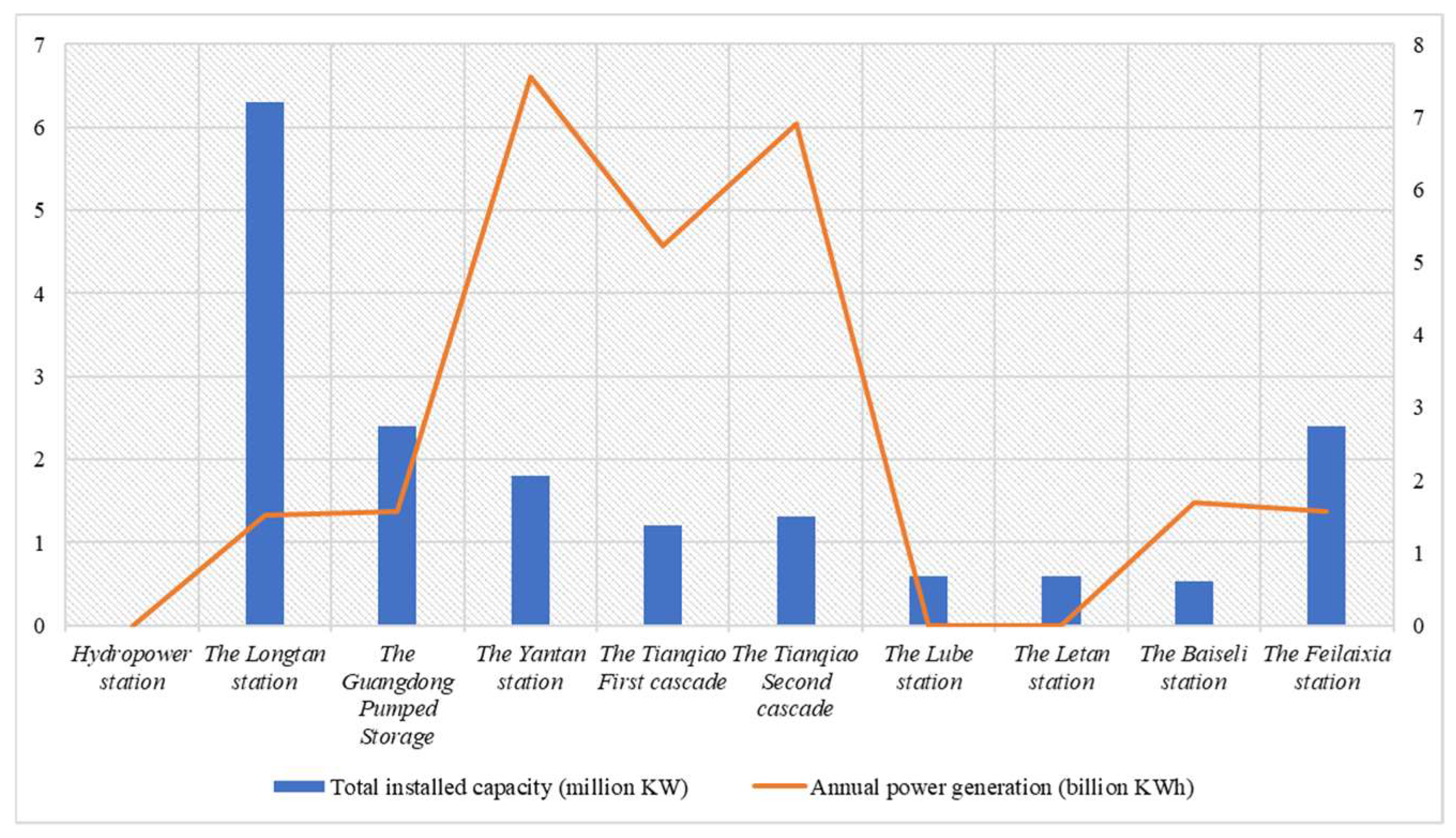
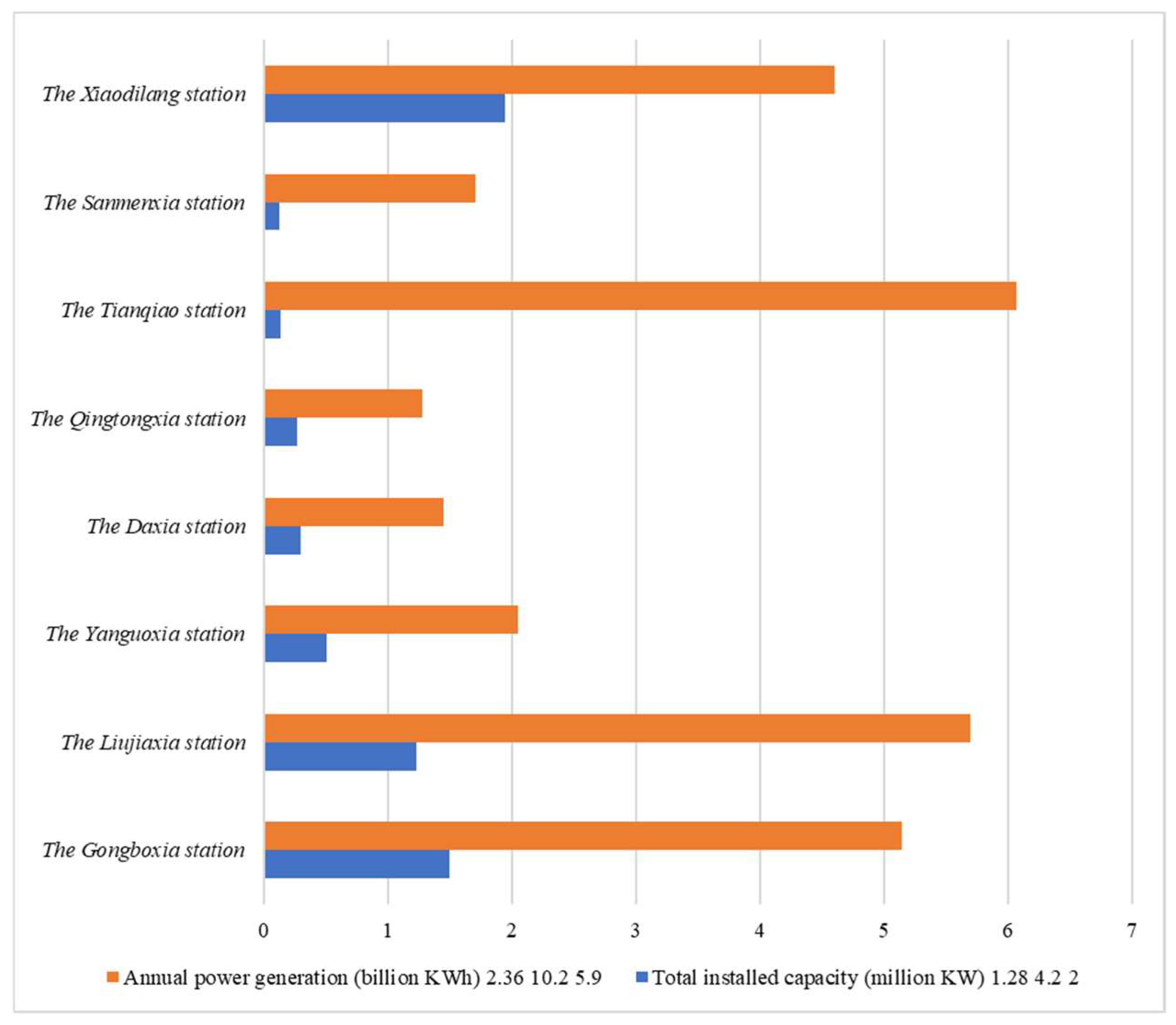
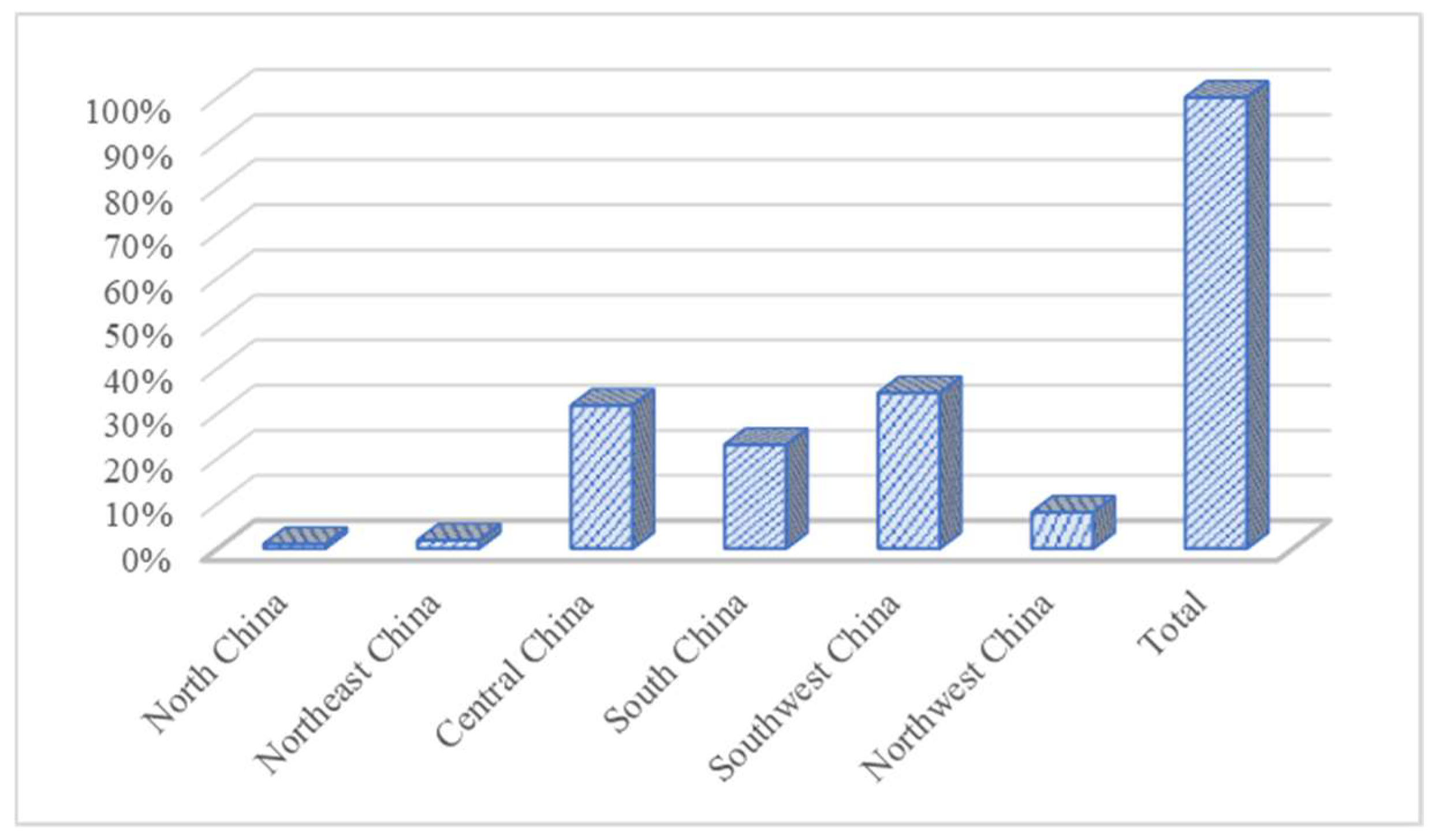
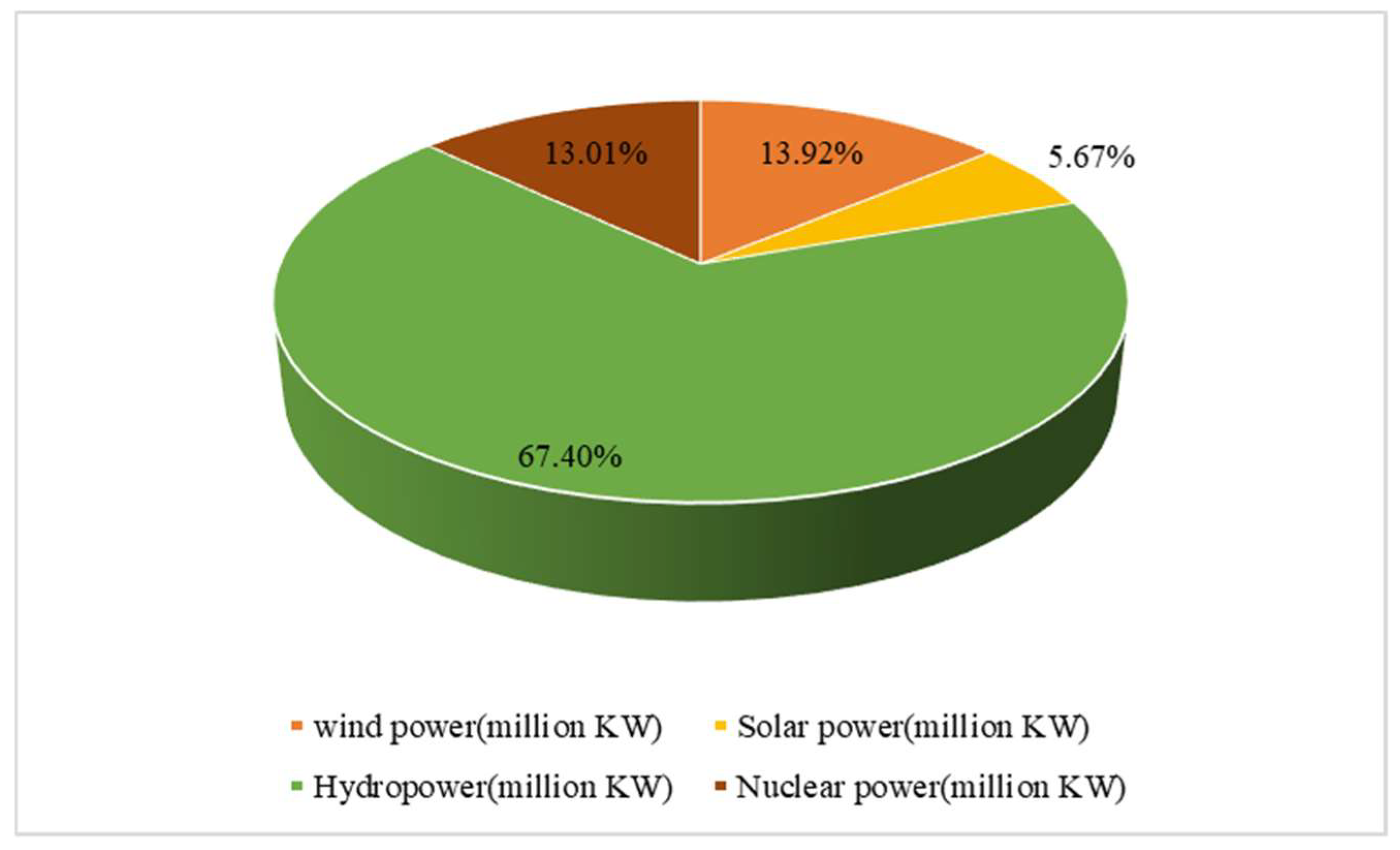
| The Main Streams | Drainage Basin | Basin Size | Theoretical Potential Hydropower (×107 KW) | Total Installed Capacity (×107 KW) | |
|---|---|---|---|---|---|
| Length (km) | Area (×105 km2) | ||||
| The West River | Yunnan, Guangxi, Guangdong | 2129.00 | 3.53 | 2.29 | 15.8 |
| The North River | Guangdong | 468.00 | 0.47 | 0.24 | 0.14 |
| The East River | Jiangxi, Guangdong | 523.00 | 0.32 | 0.93 | 0.07 |
| Total | — | 3120.00 | 4.32 | 3.46 | 16.01 |
| The River Section | Drainage Basin | Basin Size | Theoretical Potential Hydropower (×107 KW) | Total Installed Capacity (×107 KW) | |
|---|---|---|---|---|---|
| Length (km) | Area (×105 km2) | ||||
| The Upper reaches | Qinghai, Gansu, Ningxia | 3472.00 | 3.86 | 2.60 | 8.17+ |
| The Middle reaches | Inner Mongolia, Henan | 1206.00 | 3.44 | 1.26 | 3.86+ |
| The Lower reaches | Henan | 786.00 | 0.23 | 0.47 | 0.79+ |
| Total | — | 5464.00 | 7.53 | 4.33 | 12.82+ |
| Rivers | Drainage Area (104 km2) | Length of the Mainstream (km) | Basin States | ||
|---|---|---|---|---|---|
| Total | In China | Total | In China | ||
| The Nu River-Saerwen River | 32.50 | 14.27 | 3200.00 | 2013.00 | China, Burma, Thailand |
| The Lancang River-Mengong River | 80.00 | 16.70 | 4880.00 | 2129.00 | China, Burma, Thailand, Laos, Cambodia, Vietnam |
| Other rivers | — | 40.90 | — | 5829.00 | China |
| Total | — | 71.87 | — | 9981.00 | — |
| The Main Streams | Drainage Basin | Basin Size | Theoretical Potential Hydropower (×107 KW) | Total Installed Capacity (×107 KW) | |
|---|---|---|---|---|---|
| Length (km) | Area (×105 km2) | ||||
| The Minjiang River | Jiangxi, Fujian | 2959.00 | 0.61 | 0.63 | 0.37 |
| The Qiantang River | Anhui, Zhejiang | 688.00 | 0.56 | 0.24 | 0.19 |
| The Other rivers | Zhejiang, Taiwan, Fujian, Anhui, Jiangxi | — | 1.28 | 1.20 | 1.07 |
| Total | — | — | 2.45 | 2.07 | 1.63 |
| The Main Streams | Drainage Basin | Basin Size | Theoretical Potential Hydropower (×107 KW) | Total Installed Capacity (×107 KW) | |
|---|---|---|---|---|---|
| Length (km) | Area (×105 km2) | ||||
| The Heilong River | Heilongjiang, Inner Mongolia | — | 8.80 | 0.52 | — |
| The Songhua River | Heilongjiang, Jilin, Inner Mongolia | 2308.00 | 5.46 | 0.71 | 0.43 |
| The Liao River | Hebei, Inner Mongolia, Jilin, Liaoning | 1390.00 | 2.19 | 0.12 | 0.02 |
| The Yalu River | Jilin | 795.00 | 0.62 | 0.21 | 0.17 |
| The Tumen River | Jilin | 510.00 | 0.22 | 0.05 | 0.04 |
| Hydropower Station | Total Installed Capacity (Million KW) | Annual Power Generation (Billion KWh) | State | Section |
|---|---|---|---|---|
| The Three Gorge station | 22.50 | 100.00 | Constructed | Yangtze River |
| The Xiluodu station | 13.86 | 57.12 | Constructed | Jinsha River |
| The Xiangjiaba station | 6.40 | 30.75 | Constructed | Jinsha River |
| The Gezhouba station | 2.72 | 15.70 | Constructed | Yangtze River |
| The Baihetan station | 16.00 | 62.40 | Constructing | Jinsha River |
| The Wudongde station | 10.20 | 38.93 | Constructed | Jinsha River |
| The Geheyan station | 1.20 | 3.04 | Constructed | Qing River |
| The Ertan station | 3.30 | 17.00 | Constructed | Yalong River |
| The Gongzui station | 0.70 | 3.42 | Constructed | Dadu River |
| The Pubugou station | 3.60 | 14.80 | Constructed | Dadu River |
| The Wujiangdu station | 0.63 | 3.11 | Constructed | Wu River |
| The Danjiangkou station | 0.90 | 5.75 | Constructed | Tributary |
| The Wuqiangxi station | 1.20 | 5.37 | Constructed | Xiang River |
| Hydropower Station | Total Installed Capacity (Million KW) | Annual Power Generation (Billion KWh) | State | Section |
|---|---|---|---|---|
| The Longtan station | 6.30 | 1.51 | constructed | Hongshui River |
| The Guangdong Pumped Storage | 2.40 | 1.57 | constructed | Liuxi River |
| The Yantan station | 1.81 | 7.55 | constructed | Hongshui River |
| The Tianqiao First cascade | 1.20 | 5.23 | constructed | Hongshui River |
| The Tianqiao Second cascade | 1.32 | 6.90 | constructed | Hongshui River |
| The Lube station | 0.60 | 2.85 | constructed | Huangni River |
| The Letan station | 0.60 | 3..50 | constructed | Hongshui River |
| The Baiseli station | 0.54 | 1.70 | constructed | Yu River |
| The Feilaixia station | 2.40 | 1.57 | constructed | North River |
| Hydropower Station | Location | Total Installed Capacity (Million KW) | Annual Power Generation (Billion KWh) | State | Section (Yellow River) |
|---|---|---|---|---|---|
| The Longyangxia station | Qinghai Gonghe | 1.28 | 2.36 | constructed | Upstream |
| The Laxiwa station | Qinghai Guide | 4.20 | 10.20 | constructed | Upstream |
| The Lijiaxia station | Qinghai the boundary of Jianzha and Hualong | 2.00 | 5..90 | constructed | Upstream |
| The Gongboxia station | Qinghai Xunhua and Hualong | 1.50 | 5.14 | constructed | Upstream |
| The Liujiaxia station | Gansu Yongjing | 1.23 | 5.70 | constructed | Upstream |
| The Yanguoxia station | Gansu Yongjing | 0.51 | 2.05 | constructed | Upstream |
| The Daxia station | Gansu the boundary of Baiyin and Yuzhong | 0.30 | 1.45 | constructed | Upstream |
| The Qingtongxia station | Ningxia Qingtong Gorge | 0.27 | 1.28 | constructed | Upstream |
| The Tianqiao station | Shanxi Baode | 0.13 | 6.07 | constructed | Midstream |
| The Sanmenxia station | Henan Sanmenxia | 0.12 | 1.71 | constructed | Midstream |
| The Xiaodilang station | Henan Luoyang | 1.94 | 4.60 | constructed | Midstream |
| Hydropower Station | Location | Total Installed Capacity (Million KW) | Annual Power Generation (Billion KWh) | State | Section |
|---|---|---|---|---|---|
| The Gumu station | Yunnan Deqin | 2.60 | — | Planning | The Lancang River |
| The Wunonglong station | Yunnan Weixi | 0.99 | 4.12 | Constructing | The Lancang River |
| The Tuoba station | Yunnan Weixi | 1.40 | 6.07 | Constructing | The Lancang River |
| The Huangdeng station | Yunnan Lanping | 1.90 | 8.63 | Constructing | The Lancang River |
| The Dahuaqiao station | Yunnan Lanping | 0.60 | 2.75 | Constructing | The Lancang River |
| The Songta station | The boundary between Yunnan and Tibet | 3.60 | 15.90 | Constructing | The Nu River |
| The Bingzhong station | The boundary between Yunnan and Tibet | 1.65 | 1.98 | Constructing | The Nu River |
| The Bijiang station | Yunnan Fugong | 0.51 | 7.14 | Constructing | The Nu River |
| The Biluo station | Yunnan Lushui | 1.80 | 9.06 | Constructing | The Nu River |
| The Lushui station | Yunnan Lushui | 0.95 | 1.27 | Constructing | The Nu River |
| The Guangpo station | The downstream of the Nu River | 0.60 | 3.15 | Constructing | The Nu River |
| Years | Wind Power (Million KW) | Solar Power (Million KW) | Hydropower (Million KW) | Thermal Power (Million KW) | Nuclear Power (Million KW) |
|---|---|---|---|---|---|
| 2012 | 9.598 | 0.3 | 87.2107 | 9.739 | 9.598 |
| 2013 | 14.12 | 1.2 | 92.0292 | 11.161 | 14.12 |
| 2014 | 15.998 | 2.3 | 107.2882 | 13.254 | 15.998 |
| 2015 | 18.577 | 3.8 | 113.027 | 17.079 | 18.577 |
| 2016 | 23.707 | 6.2 | 118.4048 | 21.329 | 23.707 |
| 2017 | 29.723 | 11.8 | 119.7865 | 24.807 | 29.723 |
| 2018 | 36.597 | 17.75 | 123.1787 | 29.436 | 36.597 |
| 2019 | 40.57 | 22.43 | 130.4438 | 34.8131 | 40.57 |
| 2020 | 46.65 | 20.6 | 135.521 | 36.6243 | 46.65> |
Disclaimer/Publisher’s Note: The statements, opinions and data contained in all publications are solely those of the individual author(s) and contributor(s) and not of MDPI and/or the editor(s). MDPI and/or the editor(s) disclaim responsibility for any injury to people or property resulting from any ideas, methods, instructions or products referred to in the content. |
© 2023 by the authors. Licensee MDPI, Basel, Switzerland. This article is an open access article distributed under the terms and conditions of the Creative Commons Attribution (CC BY) license (https://creativecommons.org/licenses/by/4.0/).
Share and Cite
Xiao, L.; Wang, J.; Wang, B.; Jiang, H. China’s Hydropower Resources and Development. Sustainability 2023, 15, 3940. https://doi.org/10.3390/su15053940
Xiao L, Wang J, Wang B, Jiang H. China’s Hydropower Resources and Development. Sustainability. 2023; 15(5):3940. https://doi.org/10.3390/su15053940
Chicago/Turabian StyleXiao, Ling, Jing Wang, Binglin Wang, and He Jiang. 2023. "China’s Hydropower Resources and Development" Sustainability 15, no. 5: 3940. https://doi.org/10.3390/su15053940
APA StyleXiao, L., Wang, J., Wang, B., & Jiang, H. (2023). China’s Hydropower Resources and Development. Sustainability, 15(5), 3940. https://doi.org/10.3390/su15053940






